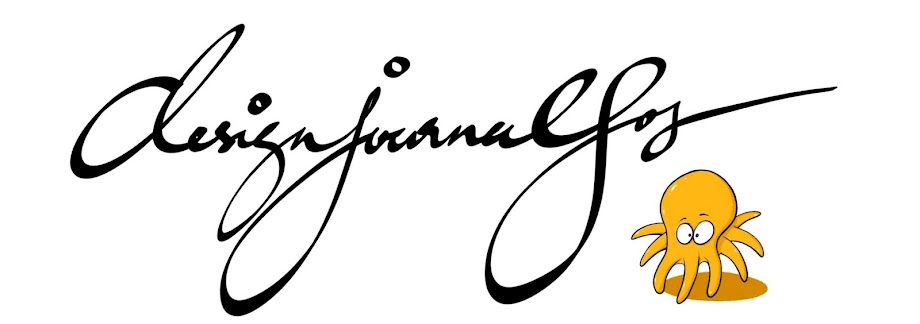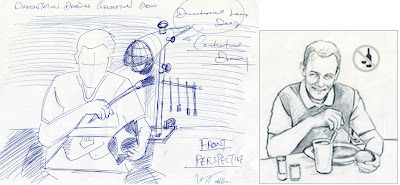First lesson for 2N1 and we are left with 15 minutes. So I did a little bit of introduction to Isometric Drawing with everyone starting to draw. Last year, I taught the same group of students how to draw in Oblique Drawing so that they can use the same technique to present their final product for submission. This year I will be introducing them the Isometric Drawing Technique. A slightly more realistic drawing technique compared to the Oblique Drawing Technique.
Next, the relation between the Oblique Drawing and the One-Point Perspective.
The interesting thing is this, a One-Point Perspective Drawing is derived from a slight deviation from an Oblique Drawing. Both still have the same full 2-D front view of the object. The only difference in a One-Point Perspective is that its 3rd dimensions are drawn aligned to a POINT (wherever the artist wish it to be). The 3rd dimensions of the Oblique Drawing are simply projected at 45 degress parallel to each other. In the One-Point Perspective Drawing, when the 3rd dimension lines are drawn towards a POINT, what you have created is an illusion that objects further away looks smaller! Therefore it looks more realistic than the Oblique Drawing.
The interesting thing is this, a One-Point Perspective Drawing is derived from a slight deviation from an Oblique Drawing. Both still have the same full 2-D front view of the object. The only difference in a One-Point Perspective is that its 3rd dimensions are drawn aligned to a POINT (wherever the artist wish it to be). The 3rd dimensions of the Oblique Drawing are simply projected at 45 degress parallel to each other. In the One-Point Perspective Drawing, when the 3rd dimension lines are drawn towards a POINT, what you have created is an illusion that objects further away looks smaller! Therefore it looks more realistic than the Oblique Drawing.
Which is better?
For the sake of comparison, as mentioned before in class the Isometric Drawing is a better option in drawing than an Oblique Drawing because the Isometric Drawing represents the real world better. Instead of parallel 3rd dimension projections, the isometric is 30 degrees off the horizontal for its 2nd and 3rd dimension. If that is the case, so it seems like the One-Point Perspective drawing is a good competition to the Isometric Drawing as far as 'realistic' representation of an object is concerned.
Well yes and no. though the One-Point Perspective does presents objects in a more realistic 3D manner (like the Isometric Drawing), a straight-forward 2-D front view to begin with still does not represent the real world very well. Take a look at objects around you, do they all appear perfectly 2-D in the front? However, the One-Point Perspective Drawing is still widely used in Interior Designs and Architecture presentations of the designed environment because they do look good if well drawn.
An even more realistic drawing technique will be the extension of the One-Point Perspective - also a slight deviation from an Isometric Drawing - It is called a Two-Point Perspective Drawing. The Two-Point Perspective Drawing is not shown in the example above but you may find it in many of my previous posts within my blog.
Alternatively you can also watch a video showing the 4 main types of drawing techniques I talked about in this post.
Just in case you are very keen, the final type of drawing technique makes use of three points and you call that a Three-Point Perspective Drawing. Ever watched Spiderman on TV or read any Marvel Spiderman Comic Book with 'Spidey' swinging from the top of the skyscrapers and the camera view showing all the actions from the sky down? Did you notice how the buildings looked like? That is a combintion of One, Two and Three Point Perspective. Cool isn' it?
Alternatively you can also watch a video showing the 4 main types of drawing techniques I talked about in this post.
Just in case you are very keen, the final type of drawing technique makes use of three points and you call that a Three-Point Perspective Drawing. Ever watched Spiderman on TV or read any Marvel Spiderman Comic Book with 'Spidey' swinging from the top of the skyscrapers and the camera view showing all the actions from the sky down? Did you notice how the buildings looked like? That is a combintion of One, Two and Three Point Perspective. Cool isn' it?
The more types of drawings you learn, the better you will be in selective the best presentation style. All drawing techniques ranging from Oblique to Isometric, extending to One-Point and Two-Point Perspectives (and even Three-Point Perspectives) can be used equallly effectively in your idea presentation. But you need to know each of their differences, their limitations and their strengths so that you can apply them meaningfully to capture the idea you want to present.
Here is a FIVE-POINT Perspective tutorial link if you are REALLY REALLY keen. It is pretty easy to understand what is going on in the tutorial. Below is my very first attempt at 5-Point Perspective Drawing much later during my free time.
Here is a FIVE-POINT Perspective tutorial link if you are REALLY REALLY keen. It is pretty easy to understand what is going on in the tutorial. Below is my very first attempt at 5-Point Perspective Drawing much later during my free time.
5-Point Perspective (Fictional) Commercial Area Sketch
Let me know if you have questions.
Let me know if you have questions.








